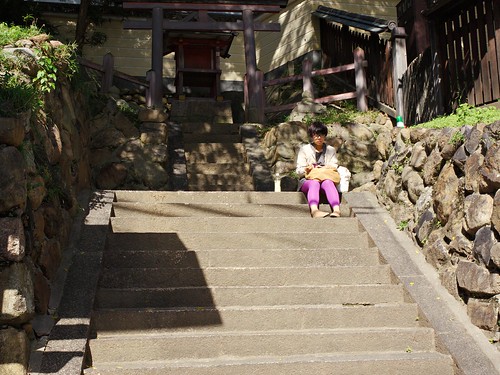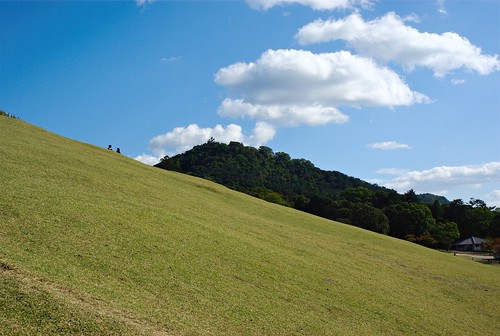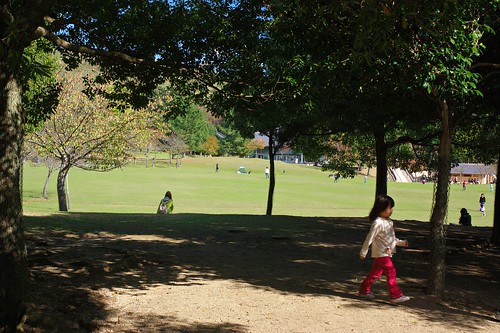So when we went to Nara a few weeks ago1 it was the first time for us in years. It was a long weekend, and the whole town was packed with tourists. It's not a large city, Nara, nor is it very scenic. Most visitors are drawn there by its history. It was the first real capital of Japan (though for less than a century) and has a very large, very old temple area in the outskirts of town2. Nara historical museum holds a large collection of early national treasures. Our visit coincided with the yearly public exhibition, and that certainly added to the throngs of people; when we passed by the museum, the line was over two hours long.
Nara is a normal town, not just an outdoor museum. If you live here the scenery is all part of your normal environment. Here a student has found himself a warm, sunny spot by some old temple.
The main draw of Nara is Todaiji, a large, old temple with the largest3 Buddha statue in Japan. The surrounding park is filled with free-wandering deer that are not to be hurt in any way, without exception even for a savoury red-wine stew of venison and potatoes with sauteed autumn vegetables. Harsh rule, that. There's no reciprocal rule of not hurting humans either, so parents need to keep an eye on their children lest they get mobbed by aggressive deer looking for snacks.
Wakakusa mountain is actually a large, steep grassy hill; it's quite spectacular in its way. The sunny hillside is pleasantly warm even in autumn and gives you a good view of Nara. Lots of couples seem to climb up here to sit together on the grass and look at the view, and a fair number of people were sliding down the steep hill on plastic mats, or bouncing a ball up the hill, then try to catch it on the way down.
Nara is a pleasant enough day trip. The temple area is pretty cool, and there's a fair amount of beautiful walking paths among the hills nearby. But there's lots more temples and shrines in Kyoto if that's the kind of stuff you're interested in, and the Fushimi Inari shrine between Kyoto and Nara is both more spectacular than the Nara hills for walking, and less crowded too. Nice, but I doubt we'll make a habit of coming here very often.
There's plenty of green spaces where people gather for picnics or playing games. With less people it would be a great place for family outings. Here's a small, determined park visitor, and Ritsuko in the background.
#1 Yes, this post is weeks late, I know. I have posts planned that should have gone up months ago. I'm very behind with work, and it's not going to improve anytime soon.
#2 It was the sheer number of temples in Nara that cut short its time as capital: the throngs of priests were so intent on playing politics that the then emperor finally simply gave up and moved house, and forbade any of the temples from following him, on pain of, well, pain I assume. The emperor left and the temples stayed behind, to the delight of modern-day Nara.
#3 Well, it's the largest statue when you ask people in Todaiji. If you go to Kamakura southwest of Tokyo they'll tell you that their Buddha is the largest. I know better than to get into a religious dispute so let's just say they're both really, impressively big and leave it at that. The Todaiji one looks cooler, though.




No comments:
Post a Comment
Comment away. Be nice. I no longer allow anonymous posts to reduce the spam.